
|
It brightened up to -4.9 mag due to the forward scattering on Oct. 9 in the SOHO coronagraph images (M. Paradowski). It became a great comet of 0 mag on the ground. Now it is 4.5 mag (Oct. 25, Yoshimi Nagai). Fading rapidly. It will be unobservable in January in the Northern Hemisphere, or in November in the Southern Hemisphere.
Date(TT) R.A. (2000) Decl. Delta r Elong. m1 Best Time(A, h)
Oct. 26 17 25.12 3 21.0 0.771 0.810 52 4.8 18:36 ( 69, 32)
Nov. 2 18 3.86 3 45.7 1.013 0.945 56 5.8 18:30 ( 66, 36)
|

|
Bright new Kreutz sungrazer comet. It approaches to Sun down to 0.008 a.u. on Oct. 28. It was expected to brighten up to 2 mag, or -4.5 mag at best. Although the brightness evolution almost stopped until mid October, a large outburst occured on Oct. 18 and it brightened up to 8.2 mag (Oct. 20, Martin Masek). However, the comet has been declining rapidly after that. Now it is 12-13 mag in the SOHO LASCO images (Oct. 24, Vladimir Bezugly). Now it is not observable. It will appear in November.
Date(TT) R.A. (2000) Decl. Delta r Elong. m1 Best Time(A, h)
Oct. 26 13 25.39 -17 16.6 0.893 0.194 10 6.1 4:50 (283,-13)
Nov. 2 13 20.11 -16 57.8 1.009 0.292 16 7.7 4:56 (287, -6)
|

|
It returned for the first time in 68 years. It brightened up to 6.2 mag in early summer (July 1, Virgilio Gonano). Now it is 9.3 mag (Oct. 20, Carlos Labordena). It will fade out rapidly after this. In the Northern Hemisphere, it will be unobservable in November. But it will be observable again in January. In the Southern Hemisphere, it is not observable now, but it will appear in January.
Date(TT) R.A. (2000) Decl. Delta r Elong. m1 Best Time(A, h)
Oct. 26 15 33.72 -3 31.1 2.918 2.054 24 11.0 18:36 ( 81, 6)
Nov. 2 15 47.43 -5 24.5 3.021 2.128 21 11.3 18:30 ( 81, 3)
|
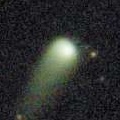
|
Now it is 12.6 mag (Oct. 13, Osamu Miyazaki). It stays 12 mag for a while. In the Northern Hemisphere, it stays observable in good condition. In the Southern Hemisphere, it is not observable now.
Date(TT) R.A. (2000) Decl. Delta r Elong. m1 Best Time(A, h)
Oct. 26 7 11.46 58 44.4 3.268 3.685 107 11.9 4:50 (181, 66)
Nov. 2 6 56.47 61 11.1 3.176 3.692 113 11.8 4:12 (180, 64)
|

|
It returns for the first time in 70 years. It brightened up to 3.7 mag in early April (Apr. 6, Jose Guilherme Aguiar). Now it is 11.5 mag (Sept. 30, Thomas Lehmann). Fading slowly. In the Northern Hemisphere, it is not observable now, but it will appear in February. It stays extremely low in the Southern Hemisphere. But it will become high in winter.
Date(TT) R.A. (2000) Decl. Delta r Elong. m1 Best Time(A, h)
Oct. 26 14 42.40 -47 31.6 3.677 2.933 36 12.5 18:36 ( 49,-27)
Nov. 2 14 56.39 -47 32.7 3.793 3.013 33 12.6 18:30 ( 50,-28)
|

|
It is expected to brighten very rapidly up to 10 mag from November to Decemebr. Now it is 16.6 mag (Oct. 17, Alan Hale). It brightens up to 9.5 mag, but it will turn to fade out rapidly after that. In the Northern Hemisphere, it stays observable in good condition. In the Southern Hemisphere, it will be unobservable in December.
Date(TT) R.A. (2000) Decl. Delta r Elong. m1 Best Time(A, h)
Oct. 26 10 45.42 1 47.6 1.561 1.210 50 14.1 4:50 (291, 30)
Nov. 2 10 53.59 4 56.2 1.373 1.176 56 12.8 4:56 (293, 36)
|

|
Now it is 13.0 mag (Sept. 20, Taras Prystavski). It stays 13 mag for a while. It will be unobservable in January in the Northern Hemisphere, or in December in the Southern Hemisphere.
Date(TT) R.A. (2000) Decl. Delta r Elong. m1 Best Time(A, h)
Oct. 26 18 11.01 -30 29.7 2.718 2.381 59 12.9 18:36 ( 36, 14)
Nov. 2 18 23.83 -28 32.2 2.788 2.374 55 13.0 18:30 ( 39, 15)
|

|
It became much brighter than expected. Now it is 13.8 mag (Sept. 8, Michael Jager). It will fade out rapidly after this. It locates somewhat low in the Northern Hemisphere. But it will become high in winter. In the Southern Hemisphere, it is not observable now, but it will appear in February.
Date(TT) R.A. (2000) Decl. Delta r Elong. m1 Best Time(A, h)
Oct. 26 13 54.90 42 39.4 2.006 1.652 55 13.5 4:50 (229, 16)
Nov. 2 14 25.32 39 55.1 2.033 1.669 54 13.6 4:56 (231, 15)
|

|
It approaches to Sun down to 0.09 a.u. on Jan. 13. According to the calculation, it will brighten up to -1 mag. But probably, it will be disintegrated. At the high light, it may be observable after the perihelion passage only in the Southern Hemisphere. Now it is 12.2 mag (Oct. 21, Hidetaka Sato). It will brighten rapidly after this. In the Northern Hemisphere, it will never be observable after this. In the Southern Hemisphere, it will be unobservable in December.
Date(TT) R.A. (2000) Decl. Delta r Elong. m1 Best Time(A, h)
Oct. 26 14 41.96 -45 7.8 2.690 1.944 33 14.0 18:36 ( 52,-26)
Nov. 2 14 54.32 -44 22.4 2.612 1.823 30 13.7 18:30 ( 53,-27)
|

|
Now it is 13.6 mag (Oct. 19, ATLAS South Africa). It will fade out rapidly after this. It will be unobservable in February in the Northern Hemisphere, or in December in the Southern Hemisphere.
Date(TT) R.A. (2000) Decl. Delta r Elong. m1 Best Time(A, h)
Oct. 26 17 36.43 -25 54.3 2.035 1.624 52 14.0 18:36 ( 45, 13)
Nov. 2 17 59.11 -25 29.8 2.080 1.632 50 14.1 18:30 ( 45, 14)
|
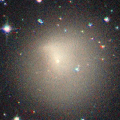
|
Now it is 14.6 mag (Sept. 29, Toshiyuki Takahashi). In the Northern Hemisphere, it stays observable in good condition. In the Southern Hemisphere, it will be getting higher gradually.
Date(TT) R.A. (2000) Decl. Delta r Elong. m1 Best Time(A, h)
Oct. 26 10 1.47 10 46.5 6.610 6.240 64 14.1 4:50 (291, 44)
Nov. 2 10 4.40 10 25.0 6.506 6.241 70 14.0 4:56 (299, 49)
|
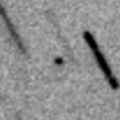
|
It will fade out rapidly after this. It will be fainter than 18 mag in February. In the Northern Hemisphere, it will be unobservable in December. But it will be observable again in January. In the Southern Hemisphere, it will never be observable after this.
Date(TT) R.A. (2000) Decl. Delta r Elong. m1 Best Time(A, h)
Oct. 26 15 29.49 -2 10.6 2.417 1.561 23 14.4 18:36 ( 83, 6)
Nov. 2 15 50.69 -2 31.9 2.512 1.650 23 14.7 18:30 ( 83, 5)
|

|
Now it is 14.1 mag (Aug. 29, Chris Wyatt). It stays 14 mag for a while. Now it is not observable. It will appear in November in the Northern Hemisphere, or in December in the Southern Hemisphere.
Date(TT) R.A. (2000) Decl. Delta r Elong. m1 Best Time(A, h)
Oct. 26 13 55.95 -19 5.5 5.981 4.995 6 14.4 4:50 (280,-20)
Nov. 2 14 3.28 -19 9.7 5.981 5.000 7 14.4 4:56 (283,-15)
|

|
It brightened up to 9.6 mag from February to March (Feb. 25, Thomas Lehmann). Now it is 14.2 mag (Oct. 1, Ken-ichi Kadota). Fading slowly. In the Northern Hemisphere, it stays observable in good condition. In the Southern Hemisphere, it will be unobservable in November.
Date(TT) R.A. (2000) Decl. Delta r Elong. m1 Best Time(A, h)
Oct. 26 19 58.21 40 3.9 3.296 3.560 97 14.5 18:36 (118, 77)
Nov. 2 20 6.00 38 35.3 3.413 3.632 94 14.6 18:30 (109, 75)
|

|
It is expected to brighten up to 13 mag in 2025 autumn, and it will be observable in good condition. Now it is 14.4 mag (Oct. 17, Ken-ichi Kadota). It stays 15 mag for a while. In the Northern Hemisphere, it stays observable in good condition. In the Southern Hemisphere, it will be getting lower gradually after this, and it will be unobservable in February.
Date(TT) R.A. (2000) Decl. Delta r Elong. m1 Best Time(A, h)
Oct. 26 22 35.61 -5 30.3 3.874 4.526 125 14.5 20:15 ( 0, 50)
Nov. 2 22 35.77 -5 28.0 3.933 4.494 118 14.5 19:48 ( 0, 50)
|
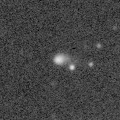
|
Now it is 14.0 mag (Oct. 23, W. Pei). It stays 14 mag for a while. It stays observable in good condition.
Date(TT) R.A. (2000) Decl. Delta r Elong. m1 Best Time(A, h)
Oct. 26 6 46.62 2 55.2 5.557 5.956 109 14.6 4:29 ( 0, 58)
Nov. 2 6 46.90 2 55.3 5.441 5.936 115 14.5 4:01 ( 0, 58)
|

|
First return of a new periodic comet which brightened up to 16 mag in 2012. Now it is 14.2 mag (Oct. 23, W. Pei). It will turn to fade out rapidly after the peak. It will be fainter than 18 mag in February. In the Northern Hemisphere, it stays observable in good condition. In the Southern Hemisphere, it will be unobservable in December.
Date(TT) R.A. (2000) Decl. Delta r Elong. m1 Best Time(A, h)
Oct. 26 4 41.87 26 43.4 0.938 1.816 139 14.6 2:25 ( 0, 82)
Nov. 2 4 34.60 31 20.2 0.906 1.819 146 14.5 1:50 ( 0, 86)
|

|
It is expected to brighten up to 13.5 mag, and it will be observable in good condition in winter. Now it is 15.9 mag (Oct. 19, ATLAS Chile). It brightens up to 13.5 mag, but it will turn to fade out rapidly after that. In the Northern Hemisphere, it stays observable in good condition. In the Southern Hemisphere, it will be getting lower gradually after this, and it will be unobservable in January.
Date(TT) R.A. (2000) Decl. Delta r Elong. m1 Best Time(A, h)
Oct. 26 6 48.94 -19 40.5 1.221 1.733 102 14.8 4:31 ( 0, 35)
Nov. 2 6 41.92 -17 2.8 1.104 1.719 110 14.6 3:57 ( 0, 38)
|

|
Now it is 16.2 mag (Oct. 24, ATLAS-HKO, Haleakala). It stays 15 mag for a while. In the Northern Hemisphere, it stays observable in good condition. In the Southern Hemisphere, it is not observable now.
Date(TT) R.A. (2000) Decl. Delta r Elong. m1 Best Time(A, h)
Oct. 26 7 19.73 66 6.1 2.155 2.605 105 15.3 4:50 (182, 59)
Nov. 2 7 37.17 67 36.4 2.103 2.595 108 15.3 4:52 (180, 57)
|
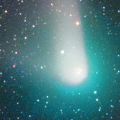
|
It brightened up to 8 mag from 2022 summer to 2023 spring. Now it is 14.9 mag (Oct. 14, Hidetaka Sato). It stays 16 mag for a while. It stays observable in good condition.
Date(TT) R.A. (2000) Decl. Delta r Elong. m1 Best Time(A, h)
Oct. 26 6 21.87 18 50.7 6.600 7.114 117 15.5 4:04 ( 0, 74)
Nov. 2 6 19.33 19 4.7 6.553 7.169 125 15.5 3:34 ( 0, 74)
|
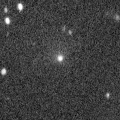
|
Very large comet. It is expected to brighten up to 13 mag in 2031. Now it is 15.2 mag (Sept. 26, Martin Masek). It stays 15 mag for a while. In the Northern Hemisphere, it is not observable now. In the Southern Hemisphere, it stays observable in good condition. In the Northern Hemisphere, it is not observable until 2030.
Date(TT) R.A. (2000) Decl. Delta r Elong. m1 Best Time(A, h)
Oct. 26 4 12.84 -69 57.2 15.705 15.815 94 15.5 1:54 ( 0,-15)
Nov. 2 4 9.59 -70 14.2 15.704 15.792 93 15.5 1:23 ( 0,-15)
|

|
It was observed at 9-10 mag for a long time in 2023. Now it is 15.2 mag (Oct. 14, ATLAS South Africa). Fading slowly. In the Northern Hemisphere, it will never be observable after this. In the Southern Hemisphere, it stays observable in good condition.
Date(TT) R.A. (2000) Decl. Delta r Elong. m1 Best Time(A, h)
Oct. 26 21 0.45 -67 47.1 5.866 5.845 83 15.5 18:41 ( 0,-13)
Nov. 2 20 56.24 -67 0.7 6.007 5.900 79 15.6 18:30 ( 2,-12)
|
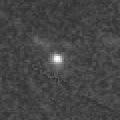
|
Now it is 15.9 mag (Sept. 30, Ken-ichi Kadota). Brightening slowly. In the Northern Hemisphere, it stays observable in good condition. In the Southern Hemisphere, it will be getting higher gradually.
Date(TT) R.A. (2000) Decl. Delta r Elong. m1 Best Time(A, h)
Oct. 26 8 46.37 23 3.9 2.618 2.717 84 15.8 4:50 (293, 66)
Nov. 2 8 54.02 22 29.1 2.517 2.706 90 15.7 4:56 (304, 70)
|

|
Now it is 15.6 mag (Oct. 25, ATLAS-HKO, Haleakala). It stays 16 mag for a while. It stays observable in good condition.
Date(TT) R.A. (2000) Decl. Delta r Elong. m1 Best Time(A, h)
Oct. 26 6 40.19 12 14.7 2.964 3.465 112 15.8 4:22 ( 0, 67)
Nov. 2 6 41.62 11 44.6 2.888 3.476 118 15.7 3:56 ( 0, 67)
|

|
Now it is 16.5 mag (Oct. 19, ATLAS Chile). It stays 16 mag for a while. It stays extremely low in the Northern Hemisphere. In the Southern Hemisphere, it stays observable in good condition.
Date(TT) R.A. (2000) Decl. Delta r Elong. m1 Best Time(A, h)
Oct. 26 9 50.09 -33 40.4 3.935 3.557 60 15.7 4:50 (327, 12)
Nov. 2 9 46.39 -35 1.6 3.891 3.602 65 15.7 4:56 (334, 14)
|
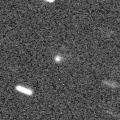
|
Now it is 16.5 mag (Apr. 3, Taras Prystavski). It stays 16 mag for a while. In the Northern Hemisphere, it will be getting higher gradually. In the Southern Hemisphere, it is not observable now, but it will appear in November.
Date(TT) R.A. (2000) Decl. Delta r Elong. m1 Best Time(A, h)
Oct. 26 11 56.80 4 40.6 2.640 1.920 35 15.8 4:50 (277, 17)
Nov. 2 12 12.32 3 19.8 2.618 1.941 38 15.8 4:56 (281, 20)
|

|
Now it is 15.7 mag (Oct. 15, ATLAS-MLO, Mauna Loa). It will fade out rapidly after this. It will be fainter than 18 mag in January. It stays observable in good condition.
Date(TT) R.A. (2000) Decl. Delta r Elong. m1 Best Time(A, h)
Oct. 26 2 13.98 6 52.4 1.419 2.409 173 15.9 23:52 ( 0, 62)
Nov. 2 2 7.54 6 41.1 1.459 2.443 170 16.1 23:18 ( 0, 62)
|

|
Now it is 16.7 mag (Oct. 16, ATLAS South Africa). Brightening slowly. It locates somewhat low in the Northern Hemisphere. But it will become high in winter. In the Southern Hemisphere, it stays observable in good condition.
Date(TT) R.A. (2000) Decl. Delta r Elong. m1 Best Time(A, h)
Oct. 26 8 16.82 -26 41.3 4.399 4.360 81 16.1 4:50 (343, 26)
Nov. 2 8 16.48 -26 49.3 4.284 4.333 86 16.0 4:56 (351, 28)
|
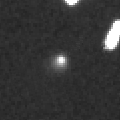
|
Now it is 16.6 mag (Oct. 25, ATLAS South Africa). It stays 16 mag for a while. It locates somewhat low in the Northern Hemisphere. In the Southern Hemisphere, it stays observable in good condition.
Date(TT) R.A. (2000) Decl. Delta r Elong. m1 Best Time(A, h)
Oct. 26 7 9.90 -28 53.9 6.715 6.875 95 16.2 4:50 ( 0, 26)
Nov. 2 7 10.38 -29 20.6 6.633 6.862 99 16.2 4:25 ( 0, 26)
|

|
It will be observable at 15 mag for a long time in 2025 in the Northern Hemisphere. Brightening slowly. In the Northern Hemisphere, it stays observable in good condition. In the Southern Hemisphere, it is not observable now, but it will appear in December.
Date(TT) R.A. (2000) Decl. Delta r Elong. m1 Best Time(A, h)
Oct. 26 11 42.58 25 6.6 5.335 4.767 50 16.3 4:50 (260, 31)
Nov. 2 11 48.03 25 49.4 5.219 4.743 56 16.2 4:56 (262, 37)
|

|
It brightened up to 8.3 mag in 2021-2022 winter (Jan. 6, 2022, Toshiyuki Takahashi). Now it is 15.1 mag (Aug. 2, Thomas Lehmann). It stays 17 mag for a while. In the Northern Hemisphere, it will never be observable after this. In the Southern Hemisphere, it will be getting higher gradually.
Date(TT) R.A. (2000) Decl. Delta r Elong. m1 Best Time(A, h)
Oct. 26 12 8.36 -49 55.3 9.634 8.947 44 16.3 4:50 (319,-18)
Nov. 2 12 12.85 -50 29.9 9.664 8.992 45 16.4 4:56 (323,-14)
|

|
Now it is 16.0 mag (Oct. 25, ATLAS-MLO, Mauna Loa). It stays 16 mag for a while. It stays observable in good condition.
Date(TT) R.A. (2000) Decl. Delta r Elong. m1 Best Time(A, h)
Oct. 26 2 4.03 19 45.1 2.131 3.119 172 16.6 23:43 ( 0, 75)
Nov. 2 1 59.10 19 2.5 2.108 3.093 171 16.5 23:10 ( 0, 74)
|

|
It stays 16 mag for a while. It locates somewhat low in the Northern Hemisphere. In the Southern Hemisphere, it will be getting higher gradually.
Date(TT) R.A. (2000) Decl. Delta r Elong. m1 Best Time(A, h)
Oct. 26 11 27.78 -20 12.0 4.379 3.644 37 16.5 4:50 (301, 7)
Nov. 2 11 37.15 -21 20.2 4.316 3.630 41 16.5 4:56 (306, 11)
|

|
Now it is 15.5 mag (Oct. 25, ATLAS Chile). It stays 17 mag for a while. It stays extremely low in the Northern Hemisphere. In the Southern Hemisphere, it stays observable in good condition.
Date(TT) R.A. (2000) Decl. Delta r Elong. m1 Best Time(A, h)
Oct. 26 7 46.36 -45 8.7 6.130 6.106 83 16.5 4:50 (353, 9)
Nov. 2 7 41.86 -46 15.8 6.116 6.150 87 16.6 4:56 ( 0, 9)
|

|
Now it is 17.2 mag (Oct. 26, Catalina Sky Survey). It stays 17 mag for a while. It stays observable in good condition.
Date(TT) R.A. (2000) Decl. Delta r Elong. m1 Best Time(A, h)
Oct. 26 22 1.17 8 58.6 0.654 1.443 120 16.7 19:42 ( 0, 64)
Nov. 2 22 16.14 8 6.2 0.667 1.430 117 16.5 19:29 ( 0, 63)
|
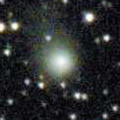
|
It brightened up to 12.1 mag in 2023 spring (May 20, 2023, Jose Guilherme de S. Aguiar). Now it is 16.8 mag (Oct. 4, ATLAS South Africa). It stays 17 mag for a while. It stays extremely low in the Northern Hemisphere. In the Southern Hemisphere, it stays observable in good condition.
Date(TT) R.A. (2000) Decl. Delta r Elong. m1 Best Time(A, h)
Oct. 26 6 55.71 -40 23.4 5.609 5.767 94 16.6 4:37 ( 0, 15)
Nov. 2 6 52.39 -40 49.1 5.599 5.816 97 16.6 4:07 ( 0, 14)
|

|
It brightened up to 12.0 mag in June (June 13, Ken-ichi Kadota). Now it is 16.1 mag (Oct. 1, Toshiyuki Takahashi). Fading slowly. It will be fainter than 18 mag in February. In the Northern Hemisphere, it stays observable in good condition. It locates somewhat low in the Southern Hemisphere.
Date(TT) R.A. (2000) Decl. Delta r Elong. m1 Best Time(A, h)
Oct. 26 9 16.95 32 45.0 2.035 2.129 81 16.7 4:50 (266, 63)
Nov. 2 9 25.77 32 22.9 2.002 2.177 86 16.7 4:56 (270, 68)
|

|
Now it is 18.9 mag (Sept. 30, Yasukazu Ikari). It stays 17 mag for a while. It stays observable in good condition.
Date(TT) R.A. (2000) Decl. Delta r Elong. m1 Best Time(A, h)
Oct. 26 8 7.85 8 19.1 4.768 4.877 90 16.7 4:50 (329, 60)
Nov. 2 8 9.79 7 25.9 4.672 4.886 96 16.7 4:56 (345, 62)
|

|
Now it is 16.9 mag (Oct. 23, ATLAS-HKO, Haleakala). It stays 17 mag for a while. It will be unobservable in February in the Northern Hemisphere, or in December in the Southern Hemisphere.
Date(TT) R.A. (2000) Decl. Delta r Elong. m1 Best Time(A, h)
Oct. 26 22 33.75 25 56.0 5.154 5.835 129 16.7 20:13 ( 0, 81)
Nov. 2 22 28.21 24 53.4 5.193 5.791 122 16.7 19:40 ( 0, 80)
|
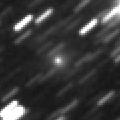
|
Very far object. Now it is 16.9 mag (Oct. 21, ATLAS Chile). It stays 17 mag for a while. In the Northern Hemisphere, it is not observable now. In the Southern Hemisphere, it stays observable in good condition.
Date(TT) R.A. (2000) Decl. Delta r Elong. m1 Best Time(A, h)
Oct. 26 1 39.13 -69 23.7 10.291 10.477 98 16.8 23:17 ( 0,-14)
Nov. 2 1 30.10 -69 5.0 10.341 10.484 95 16.8 22:40 ( 0,-14)
|

|
Now it is 17.2 mag (Oct. 22, Hidetaka Sato). Brightening gradually. It will be unobservable in December. It will brighten up to 14.5 mag in 2025 spring. But the condition is bad.
Date(TT) R.A. (2000) Decl. Delta r Elong. m1 Best Time(A, h)
Oct. 26 17 13.85 -20 57.0 2.801 2.237 46 16.9 18:36 ( 52, 13)
Nov. 2 17 28.15 -21 36.2 2.836 2.215 42 16.8 18:30 ( 53, 12)
|

|
Now it is 16.3 mag (Oct. 20, ATLAS Chile). Fading gradually. It will be fainter than 18 mag in December. It stays observable in good condition.
Date(TT) R.A. (2000) Decl. Delta r Elong. m1 Best Time(A, h)
Oct. 26 0 39.32 -3 46.2 1.087 2.027 153 16.8 22:18 ( 0, 51)
Nov. 2 0 37.94 -3 56.1 1.125 2.029 146 16.9 21:50 ( 0, 51)
|

|
First return of a new periodic comet which brightened up to 15 mag in 2010. It is expected to brighten up to 15 mag from winter to spring, and it will be observable in excellent condition in the Northern Hemisphere. But actually, it is fainter than this ephemeris. Now it is 18.1 mag (Oct. 22, Purple Mountain Observatory, XuYi Station). Brightening slowly. It stays observable in good condition.
Date(TT) R.A. (2000) Decl. Delta r Elong. m1 Best Time(A, h)
Oct. 26 2 56.32 4 43.9 1.235 2.209 164 17.1 0:39 ( 0, 60)
Nov. 2 2 50.19 5 3.2 1.178 2.160 169 16.9 0:06 ( 0, 60)
|

|
It brightened up to 14.4 mag in summer (Aug. 17, Hiroshi Abe). Now it is 16.8 mag (Oct. 17, ATLAS-MLO, Mauna Loa). It will fade out rapidly after this. It will be fainter than 18 mag in December. In the Northern Hemisphere, it stays observable in good condition. It locates somewhat low in the Southern Hemisphere.
Date(TT) R.A. (2000) Decl. Delta r Elong. m1 Best Time(A, h)
Oct. 26 6 22.71 30 45.4 0.986 1.694 117 16.9 4:05 ( 0, 86)
Nov. 2 6 23.96 33 31.1 0.973 1.736 124 17.0 3:39 ( 0, 88)
|

|
Now it is 17.5 mag (Sept. 23, A. Diepvens). Fading slowly. It will be fainter than 18 mag in February. It stays observable in good condition.
Date(TT) R.A. (2000) Decl. Delta r Elong. m1 Best Time(A, h)
Oct. 26 22 39.37 -6 53.7 1.338 2.084 126 17.0 20:19 ( 0, 48)
Nov. 2 22 42.84 -6 27.7 1.387 2.070 120 17.0 19:55 ( 0, 49)
|
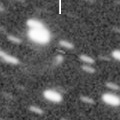
|
Now it is 17.4 mag (Oct. 20, ATLAS-MLO, Mauna Loa). It stays 18 mag for a while. In the Northern Hemisphere, it will be getting lower gradually. But it will be getting higher again after January. In the Southern Hemisphere, it will be unobservable in November. But it will be observable again in February.
Date(TT) R.A. (2000) Decl. Delta r Elong. m1 Best Time(A, h)
Oct. 26 19 5.22 24 37.3 4.585 4.565 82 17.2 18:36 ( 74, 64)
Nov. 2 19 5.21 22 59.6 4.702 4.587 77 17.2 18:30 ( 76, 59)
|

|
Now it is 17.6 mag (Oct. 9, ATLAS South Africa). It stays 17 mag for a while. It stays observable in good condition.
Date(TT) R.A. (2000) Decl. Delta r Elong. m1 Best Time(A, h)
Oct. 26 4 18.25 -13 12.9 3.189 3.981 137 17.2 2:01 ( 0, 42)
Nov. 2 4 15.53 -14 10.2 3.159 3.979 140 17.2 1:31 ( 0, 41)
|

|
It will brighten up to 14 mag in 2025 spring. Now it is 17.0 mag (Oct. 18, ATLAS Chile). Brightening gradually. It locates somewhat low in the Northern Hemisphere. In the Southern Hemisphere, it stays observable in good condition.
Date(TT) R.A. (2000) Decl. Delta r Elong. m1 Best Time(A, h)
Oct. 26 23 38.68 -30 56.6 1.504 2.225 124 17.2 21:18 ( 0, 24)
Nov. 2 23 35.75 -30 41.3 1.524 2.178 118 17.2 20:47 ( 0, 24)
|

|
Now it is 17.5 mag (Oct. 9, D. Buczynski). Brightening slowly. It locates somewhat low in the Northern Hemisphere. In the Southern Hemisphere, it is not observable now. It will brighten up to 15.5 mag from winter to spring. But it is not observable around the high light.
Date(TT) R.A. (2000) Decl. Delta r Elong. m1 Best Time(A, h)
Oct. 26 15 47.70 37 48.6 2.956 2.537 55 17.4 18:36 (117, 30)
Nov. 2 16 4.89 37 19.4 2.883 2.481 56 17.2 18:30 (117, 29)
|

|
Parent asteroid of Geminids meteor shower. Now it is 18.5 mag (Sept. 12, ATLAS-HKO, Haleakala). Brightening slowly. In the Northern Hemisphere, it stays observable in good condition. It locates somewhat low in the Southern Hemisphere.
Date(TT) R.A. (2000) Decl. Delta r Elong. m1 Best Time(A, h)
Oct. 26 5 11.02 39 3.7 1.334 2.120 130 17.6 2:54 (180, 86)
Nov. 2 4 58.70 39 27.3 1.227 2.081 139 17.3 2:15 (180, 86)
|
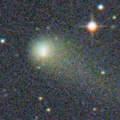
|
It brightened up to 11.1 mag in early 2022 (Mar. 31, 2022, F. Kugel, J.-G. Bosch, J. Nicolas). Now it is 16.9 mag (Oct. 20, ATLAS-MLO, Mauna Loa). It stays 18 mag for a while. In the Northern Hemisphere, it will be getting lower gradually. But it will be getting higher again after December. In the Southern Hemisphere, it will never be observable after this.
Date(TT) R.A. (2000) Decl. Delta r Elong. m1 Best Time(A, h)
Oct. 26 17 32.98 25 18.3 8.343 7.953 63 17.3 18:36 ( 92, 45)
Nov. 2 17 36.82 24 56.8 8.435 7.994 60 17.4 18:30 ( 94, 42)
|

|
First return of a new periodic comet which brightened up to 15 mag in 2010. Now it is 17.4 mag (Oct. 13, Ken-ichi Kadota). It stays 18 mag for a while. In the Northern Hemisphere, it stays observable in good condition. It locates somewhat low in the Southern Hemisphere.
Date(TT) R.A. (2000) Decl. Delta r Elong. m1 Best Time(A, h)
Oct. 26 9 1.48 29 44.0 1.913 2.056 83 17.4 4:50 (275, 66)
Nov. 2 9 12.49 29 29.6 1.874 2.092 88 17.4 4:56 (280, 70)
|

|
Now it is 16.8 mag (Oct. 19, ATLAS South Africa). It stays 18 mag for a while. It will be unobservable in January.
Date(TT) R.A. (2000) Decl. Delta r Elong. m1 Best Time(A, h)
Oct. 26 19 23.26 -22 30.1 3.435 3.344 76 17.4 18:36 ( 24, 28)
Nov. 2 19 30.59 -22 21.7 3.525 3.339 71 17.4 18:30 ( 28, 27)
|
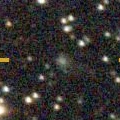
|
Now it is 17.6 mag (Oct. 13, Ken-ichi Kadota). It stays 18 mag for a while. In the Northern Hemisphere, it stays observable in good condition. It stays extremely low in the Southern Hemisphere.
Date(TT) R.A. (2000) Decl. Delta r Elong. m1 Best Time(A, h)
Oct. 26 7 40.90 39 48.5 6.688 6.962 101 17.5 4:50 (232, 82)
Nov. 2 7 42.26 40 2.1 6.598 6.974 108 17.5 4:56 (182, 85)
|

|
Now it is 17.5 mag (Oct. 22, ATLAS-HKO, Haleakala). It will fade out rapidly after this. It will be fainter than 18 mag in November. In the Northern Hemisphere, it stays observable in good condition. It stays extremely low in the Southern Hemisphere.
Date(TT) R.A. (2000) Decl. Delta r Elong. m1 Best Time(A, h)
Oct. 26 2 16.23 37 20.1 1.429 2.367 154 17.5 23:55 (180, 87)
Nov. 2 2 6.90 38 6.2 1.439 2.380 156 17.6 23:18 (180, 87)
|

|
Now it is 17.5 mag (Oct. 2, ATLAS Chile). It stays 17 mag for a while. It will be unobservable in December. But it will be observable again in January in the Southern Hemisphere, or in February in the Northern Hemisphere. It is expected to brighten up to 13 mag in 2026, and it will be observable in excellent condition in the Northern Hemisphere. In the Southern Hemisphere, it locates very low at the high light.
Date(TT) R.A. (2000) Decl. Delta r Elong. m1 Best Time(A, h)
Oct. 26 18 27.23 -34 40.3 7.672 7.284 63 17.5 18:36 ( 31, 12)
Nov. 2 18 29.64 -34 9.8 7.730 7.240 57 17.5 18:30 ( 34, 11)
|

|
Peculiar asteroid moving along a cometary orbit. It stays 18 mag for a while. It stays observable in good condition.
Date(TT) R.A. (2000) Decl. Delta r Elong. m1 Best Time(A, h)
Oct. 26 4 1.41 -7 28.4 2.128 2.992 144 17.7 1:44 ( 0, 48)
Nov. 2 3 58.08 -9 2.7 2.055 2.942 147 17.6 1:13 ( 0, 46)
|

|
Peculiar asteroid moving along a cometary orbit. It will approach to Sun down to 0.49 a.u. on Nov. 29. Fading slowly. It will be fainter than 18 mag in November. It locates somewhat low in the Northern Hemisphere. In the Southern Hemisphere, it will be unobservable in December.
Date(TT) R.A. (2000) Decl. Delta r Elong. m1 Best Time(A, h)
Oct. 26 10 24.56 -3 37.3 0.873 0.861 54 17.8 4:50 (300, 30)
Nov. 2 11 2.63 -14 48.0 0.649 0.758 49 17.6 4:56 (307, 21)
|

|
Now it is 17.0 mag (Sept. 14, Ken-ichi Kadota). It stays 18 mag for a while. It stays observable in good condition.
Date(TT) R.A. (2000) Decl. Delta r Elong. m1 Best Time(A, h)
Oct. 26 3 24.74 16 38.5 3.560 4.505 159 17.7 1:08 ( 0, 72)
Nov. 2 3 20.31 16 28.8 3.544 4.518 167 17.7 0:36 ( 0, 72)
|

|
Now it is 17.2 mag (Oct. 23, ATLAS Chile). It will fade out rapidly after this. It will be fainter than 18 mag in November. It stays observable in good condition.
Date(TT) R.A. (2000) Decl. Delta r Elong. m1 Best Time(A, h)
Oct. 26 23 9.19 -17 50.6 1.956 2.682 127 17.7 20:49 ( 0, 37)
Nov. 2 23 9.41 -16 57.3 2.055 2.708 121 17.9 20:21 ( 0, 38)
|

|
Now it is 18.5 mag (Oct. 10, D. Buczynski). It stays 18 mag for a while. In the Northern Hemisphere, it stays observable in good condition. It locates somewhat low in the Southern Hemisphere.
Date(TT) R.A. (2000) Decl. Delta r Elong. m1 Best Time(A, h)
Oct. 26 9 36.58 32 33.0 2.410 2.402 77 17.7 4:50 (264, 59)
Nov. 2 9 45.82 32 11.0 2.361 2.436 82 17.7 4:56 (268, 64)
|
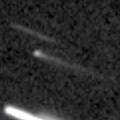
|
Now it is 16.4 mag (Oct. 25, ATLAS-MLO, Mauna Loa). It stays 18 mag for a while. It stays observable in good condition.
Date(TT) R.A. (2000) Decl. Delta r Elong. m1 Best Time(A, h)
Oct. 26 3 4.13 12 53.2 2.936 3.904 164 17.8 0:47 ( 0, 68)
Nov. 2 3 0.47 12 15.0 2.918 3.903 172 17.8 0:16 ( 0, 67)
|

|
Now it is 19.4 mag (Oct. 15, Mt. Lemmon Survey). It stays 18 mag for a while. In the Northern Hemisphere, it stays observable in good condition. It locates somewhat low in the Southern Hemisphere.
Date(TT) R.A. (2000) Decl. Delta r Elong. m1 Best Time(A, h)
Oct. 26 7 8.36 29 41.3 1.735 2.246 107 18.0 4:50 ( 0, 85)
Nov. 2 7 15.46 31 3.4 1.659 2.244 113 17.9 4:30 ( 0, 86)
|
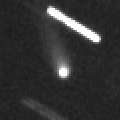
|
It has started fading before the perihelion passage. Now it is 17.0 mag (Aug. 11, Thomas Lehmann). It stays 18 mag for a while. In the Northern Hemisphere, it will never be observable after this. It locates somewhat low in the Southern Hemisphere.
Date(TT) R.A. (2000) Decl. Delta r Elong. m1 Best Time(A, h)
Oct. 26 13 29.04 -61 28.5 3.492 2.944 49 17.9 4:50 (326,-33)
Nov. 2 13 47.43 -60 51.4 3.560 2.970 46 18.0 4:56 (326,-31)
|

|
Now it is 17.8 mag (Oct. 10, Yasukazu Ikari). It will fade out rapidly after this. In the Northern Hemisphere, it stays observable in good condition. It stays extremely low in the Southern Hemisphere.
Date(TT) R.A. (2000) Decl. Delta r Elong. m1 Best Time(A, h)
Oct. 26 4 6.59 50 10.8 1.226 2.049 134 17.9 1:50 (180, 75)
Nov. 2 4 1.31 51 3.9 1.220 2.075 139 18.1 1:17 (180, 74)
|
|
![]()
 C/2023 C2 ( ATLAS )
C/2023 C2 ( ATLAS ) C/2024 B1 ( Lemmon )
C/2024 B1 ( Lemmon ) C/2024 G3 ( ATLAS )
C/2024 G3 ( ATLAS ) 37P/Forbes
37P/Forbes 29P/Schwassmann-Wachmann 1
29P/Schwassmann-Wachmann 1 C/2023 R2 ( PanSTARRS )
C/2023 R2 ( PanSTARRS ) C/2021 G2 ( ATLAS )
C/2021 G2 ( ATLAS ) C/2021 S3 ( PanSTARRS )
C/2021 S3 ( PanSTARRS ) C/2022 N2 ( PanSTARRS )
C/2022 N2 ( PanSTARRS ) C/2022 QE78 ( ATLAS )
C/2022 QE78 ( ATLAS ) 487P/2024 N5 ( Siding Spring )
487P/2024 N5 ( Siding Spring ) C/2024 M1 ( ATLAS )
C/2024 M1 ( ATLAS ) C/2023 Q1 ( PanSTARRS )
C/2023 Q1 ( PanSTARRS ) C/2017 K2 ( PanSTARRS )
C/2017 K2 ( PanSTARRS ) C/2014 UN271 ( Bernardinelli-Bernstein )
C/2014 UN271 ( Bernardinelli-Bernstein ) C/2020 V2 ( ZTF )
C/2020 V2 ( ZTF ) P/2023 S1
P/2023 S1 472P/2023 RL75 ( NEAT-LINEAR )
472P/2023 RL75 ( NEAT-LINEAR ) C/2022 L2 ( ATLAS )
C/2022 L2 ( ATLAS ) 30P/Reinmuth 1
30P/Reinmuth 1 130P/McNaught-Hughes
130P/McNaught-Hughes C/2024 A1 ( ATLAS )
C/2024 A1 ( ATLAS ) C/2022 R6 ( PanSTARRS )
C/2022 R6 ( PanSTARRS ) C/2023 H5 ( Lemmon )
C/2023 H5 ( Lemmon ) C/2019 L3 ( ATLAS )
C/2019 L3 ( ATLAS ) 43P/Wolf-Harrington
43P/Wolf-Harrington C/2023 T3 ( Fuls )
C/2023 T3 ( Fuls ) C/2019 U5 ( PanSTARRS )
C/2019 U5 ( PanSTARRS ) 305P/Skiff
305P/Skiff C/2020 K1 ( PanSTARRS )
C/2020 K1 ( PanSTARRS ) 154P/Brewington
154P/Brewington C/2022 U3 ( Bok )
C/2022 U3 ( Bok ) C/2023 R1 ( PanSTARRS )
C/2023 R1 ( PanSTARRS ) C/2019 E3 ( ATLAS )
C/2019 E3 ( ATLAS ) 48P/Johnson
48P/Johnson 253P/PanSTARRS
253P/PanSTARRS P/2024 S3 ( Hill )
P/2024 S3 ( Hill ) 146P/Shoemaker-LINEAR
146P/Shoemaker-LINEAR 190P/Mueller
190P/Mueller C/2022 U1 ( Leonard )
C/2022 U1 ( Leonard ) 242P/Spahr
242P/Spahr 49P/Arend-Rigaux
49P/Arend-Rigaux C/2024 J2 ( Wierzchos )
C/2024 J2 ( Wierzchos ) (3200) Phaethon
(3200) Phaethon C/2019 T4 ( ATLAS )
C/2019 T4 ( ATLAS ) 492P/2024 O3 ( LINEAR )
492P/2024 O3 ( LINEAR ) 302P/Lemmon-PanSTARRS
302P/Lemmon-PanSTARRS C/2021 S4 ( Tsuchinshan )
C/2021 S4 ( Tsuchinshan ) 338P/McNaught
338P/McNaught C/2024 J3 ( ATLAS )
C/2024 J3 ( ATLAS ) (308607) 2005 WY3
(308607) 2005 WY3 (343158) Marsyas
(343158) Marsyas 117P/Helin-Roman-Alu 1
117P/Helin-Roman-Alu 1 89P/Russell 2
89P/Russell 2 50P/Arend
50P/Arend 276P/Vorobjov
276P/Vorobjov 33P/Daniel
33P/Daniel C/2022 S4 ( Lemmon )
C/2022 S4 ( Lemmon ) 328P/LONEOS-Tucker
328P/LONEOS-Tucker![]()




























































